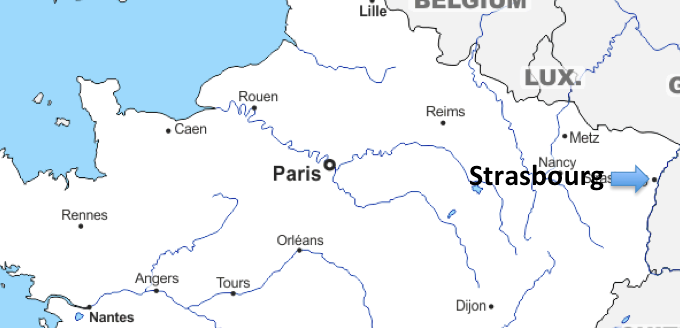
A European Journey #28 – Strasbourg (France)
We will continue our mini-trip in the footsteps of the Waldensians and study the spread of their work in Europe before the Reformation.
For the third stage of this mini-trip, we will again be in France but this time in Strasbourg. This city is the capital of Alsace, a region where French and a Germanic language called Alsatian are spoken. This is no surprise, since the city is located only a few kilometres from the Rhine river, which separates France from Germany.
Throughout its history, Strasbourg has often been passed between the two countries. Today however, it is the seat of the European Parliament, a symbol of the Franco-German reconciliation after the Second World War.
To find traces of the Waldensians, we will again visit the historical centre, where the magnificent Cathedral is located. Last week I mentioned that the Cathedral of Metz has the third highest nave in France. Well, here, the Cathedral of Strasbourg has the second highest spire in France and it is actually also the sixth highest of the world.
Strasbourg, which gained its status of Free Imperial City in 1244, was, like Metz, a relatively free city. This atmosphere of freedom allowed trade to take place and rich merchants to live there. However, even the clergy seemed to adopt an extravagant lifestyle.
This relative freedom allowed the Waldensians to thrive here, just like in Metz, as we saw last week. In contrast to the extravagance of the clergy, the Waldensians lived a simple lifestyle. Their vow of poverty and their willingness to work for one another (a principle called solidarity through work) helped them gain a lot of disciples in the city.
The Catholic Church began to see the Waldensians as a threat to the church, because they claimed to be disciples of the Apostles, to be guided by the Holy Spirit, and especially because they insisted on preaching the gospel. This is something that the Catholic Church considered to be an exclusive right of the clergy.
One particular event shows how it was costly for the Waldensians to live according to their convictions.
In the beginning of the thirteenth century, the Dominican order became the Pope’s military arm and began to gain the reputation of being highly efficient at dealing with heresies, most famously through their crusades against the Cathars and the Waldensians in the South of France. This inspired the bishop of Strasbourg to call for their help.
The main leader of the Waldensians in Strasbourg at the time was a man named Jean Le Presbytre. In the year 1211, Jean was arrested and put under trial. Nineteenth century Italian historian Emilio Comba relates some of the exchanges between Jean and his judges. When they threatened him that his case could be dealt with through the red-hot iron, an instrument of torture, Jean said: “That would be tempting God”. In response to this the Catholics insinuated that he was afraid to burn his little finger. So Jean declared: “Here is more than the finger, here is my body. It is ready to be burned if this means to pay tribute to God”.
Well, this is exactly what happened. Jean Le Presbytre was indeed burned at the stake, together with 79 other Waldensians, including 12 priests and 23 women.
This trial was just the beginning of decades of persecutions all around Europe. In Germany especially, a Dominican monk named Konrad von Marburg became one of their most famous inquisitors. But in spite of the 1211 massacre, Strasbourg eventually became a land of refuge for the Waldensians from Germany. Interestingly enough, this roughly coincides with the time when Strasbourg became a city-state.
From Strasbourg, missionaries were sent to Germany and even Bohemia. The vitality of the Waldensian movement seemed to weaken through the ages however. Then in the year 1400, another trial was held against the Waldensians. This time it resulted in the exile of some of its prominent members. After the trial, the Waldensian presence in Strasbourg seems to have disappeared.
Nevertheless, their intense missionary activity had guaranteed a lasting impact on certain lands. In fact, we find that several Reformations sprang up in lands where they had been actively present. This was certainly the case with the Reformation led by Jan Hus in Bohemia, the one led by Martin Luther in Germany, and also the Reformation led by Martin Bucer and John Calvin in Strasbourg itself. Surely the commitment of the Waldensians to spread the Scriptures has something to do with this.
Nowadays, freedom of conscience is increasingly seen as the right to live according our own whims, independently of whether it is right or wrong. But if we seek to know where that freedom of conscience comes from, we realize that it came through these people who stood for their freedom to obey God’s Word even at the cost of their own lives.
See you next week somewhere else in Europe.
Cédric Placentino
Schuman Centre convener for Italian and French Europe
Follow A European Journey here.

This Post Has 0 Comments